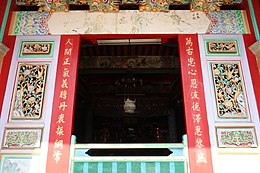Type of couplet in Chinese poetry
In Chinese poetry, a duilian (simplified Chinese: 对联; traditional Chinese: 對聯; pinyin: duìliánⓘ) is a pair of lines of poetry which adhere to certain rules (see below). Outside of poems, they are usually seen on the sides of doors leading to people's homes or as hanging scrolls in an interior. Although often called Chinese couplet or antithetical couplet, they can better be described as a written form of counterpoint. The two lines have a one-to-one correspondence in their metrical length, and each pair of characters must have certain corresponding properties. A duilian is ideally profound yet concise, using one character per word in the style of Classical Chinese. A special, widely-seen type of duilian is the chunlian (simplified Chinese: 春联; traditional Chinese: 春聯; pinyin: chūnlián), used as a New Year's decoration that expresses happiness and hopeful thoughts for the coming year.
